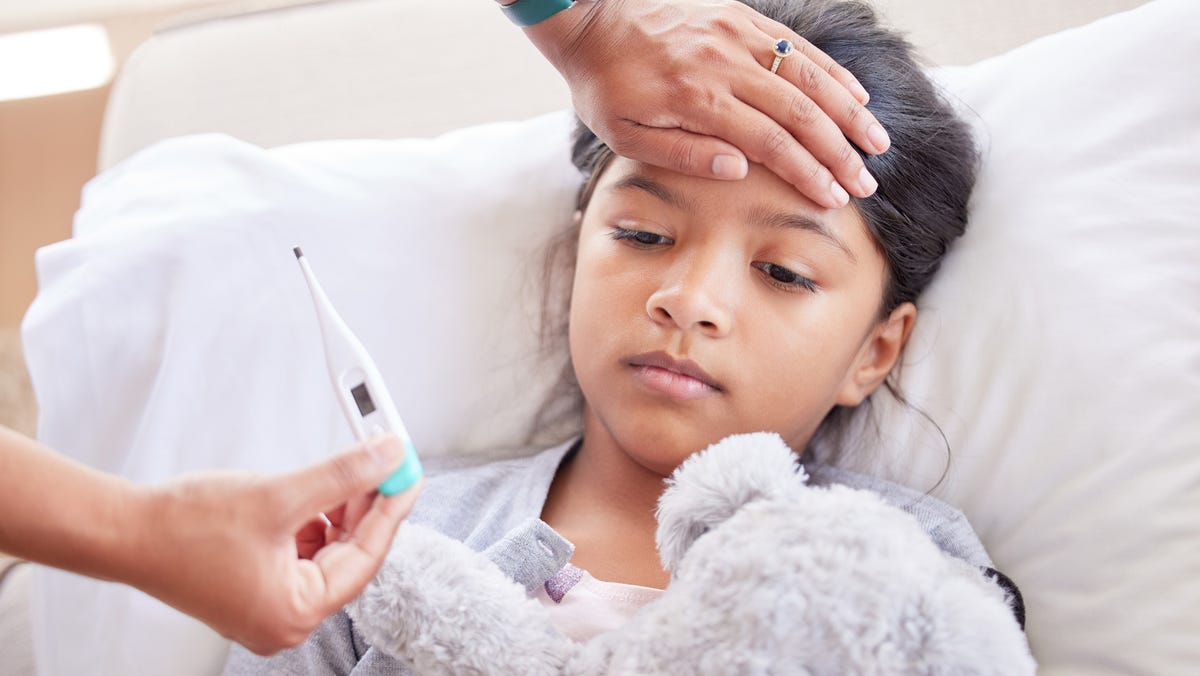As winter continues to drag along, so does cold and flu season. This year, parents and experts alike expressed concern over the “tripledemic” expected to rage through the winter months, as RSV, COVID-19 and the flu all came out to play along with the typical common cold.
Existing health conditions play a major role in how seriously any of these illnesses impact you, and the highest levels of concern are generally reserved for people with weaker immune systems to fight off sickness – namely, people with autoimmune conditions, older people and children.
As a result, this flu season, like most others, has been particularly hard on children. News of influenza-related pediatric deaths periodically make headlines, but experts say there is no need to panic; instead, just be vigilant and careful.
Flu season can be concerning for any parent or caregiver, but there are plenty of resources for ensuring your child gets proper care and stays safe this season and those to come.
COVID vaccine: Latest COVID shots are 54% effective against symptomatic infection in adults, CDC says
2023-2024 flu season for kids
Pediatric infectious disease specialist Dr. Kris Bryant told USA TODAY that this flu season has been more or less normal as far as pediatric cases. Bryant, who is a specialist at Norton Children’s Hospital in Lousiville Kentucky and a member of the American Academy of Pediatrics Committee on Infectious Diseases, said a usual or “typical” season still entails a lot of people getting sick.
“So far, this seems like the typical flu season that we saw prior to the pandemic,” she said. “Recognize that a ‘typical flu season’ results in a lot of outpatient healthcare visits and hospitalizations and even some deaths in children.”
According to the most recent data from the Centers for Disease Control and Prevention, there were 10 influenza-related pediatric deaths in the week ending Jan. 20, bringing the total to 57 thus far for the 2023-2024 flu season. The “season” as categorized by the CDC, runs from late fall to early spring, and 106 total pediatric deaths were reported to the CDC by February of the 2022-2023 season, the highest number since the start of the COVID-19 pandemic.
“In the decade before the pandemic, the number of pediatric flu deaths ranged from 37 in the 2011-12 season to 199 in the 2019-20 season,” Bryant told USA TODAY. “The final total for last season was 183 deaths. That’s a scary number for both parents and pediatricians.”
According to the CDC report, 103 of the 106 children who died by February of last year were eligible for vaccination and vaccination status was known for 81 of those. Of those children, 90% were not fully vaccinated against the flu. The CDC has been keeping track of pediatric flu deaths since 2004 but says the real number of cases is likely significantly underreported.
How to protect your kids from the flu
One of the first and most important steps for protecting your child from the flu is to vaccinate them against it, say experts.
“Vaccination is effective at preventing the most severe complication of flu,” said Bryant. “In some years, we see flu cases throughout the spring. It is not too late to receive a flu shot.”
What to know about Paxlovid: Paxlovid is a potential lifesaver. So why aren’t more people taking it?
Most children over the age of six months are eligible for their flu shots, which are especially important for kids under the age of five, the CDC says. Young children are more likely to develop serious symptoms and complications that require hospitalization, but vaccination reduces the severity and length of illnesses and decreases the rate of death and hospitalization.
Bryant said that some kids – including those younger than 5 years of age and especially children younger than 2 and/or kids who have chronic medical conditions – are more at risk for developing severe, complicated influenza. That said, she doesn’t want parents to think that because their child is otherwise healthy or older, they don’t have to worry about the flu, as it can cause complications for any child.
“Last year, 65 of the first 106 pediatric flu deaths reported in the U.S. occurred in children 5 to 17 years of age. Typically, about half of pediatric flu deaths occur in children without underlying medical conditions,” said Bryant. “It can be really difficult to know which child will become really sick from flu, which is one reason that flu vaccine is recommended for everyone 6 months and older.”
Parents and caregivers of children too young to receive a flu shot should be immunized themselves, Bryant said. Keeping flu out of your home and immediate circle can also be a useful practice for keeping your kids healthy: she suggests minimizing contact with other people who are sick and practicing good handwashing and hygiene.
What to watch out for if your child catches the flu
Between school, family, friends, siblings and extracurricular activities, even the most careful of families may end up battling unwanted flu infections. With the common cold, COVID-19, RSV and multiple strains of the same illnesses all floating around at the same time, it can be difficult to determine if your young family members are suffering from the flu or something else.
According to the CDC, some signs to watch out for, especially in children under 5, are:
- A fever, which is is a temperature greater than or equal to 100 degrees Fahrenheit in kids (37.8 degrees Celsius).
- Other physical symptoms of fever, such as skin that feels warm to the touch, a flushed appearance, sweating or shivering.
- Body aches.
- Fatigue.
- Headache.
- Sore throat and/or cough.
- Congestion or runny nose.
- Stomach upset and/or vomiting.
Antibiotics and how they work: How do antibiotics work, what happens to your body when you take them? We’ve got answers
Discerning when infants and toddlers feel sick can be a little trickier, as they have fewer means to communicate their needs and feelings to us. Some additional signs to look out for specifically in babies and very young children include:
- Irritability and frequent crying.
- Trouble feeding or refusal to feed.
- Trouble sleeping.
Flu can also result in the worsening of underlying medical conditions and that can land some kids in the hospital, according to Bryant.
“In terms of how flu makes kids really sick, some who develop severe influenza have an overwhelming viral infection,” she said. “Other kids with flu may develop a secondary bacterial pneumonia or sepsis In prior flu seasons, I have taken care of kids who developed severe infections due to Staph or Strep germs shortly after they were diagnosed with flu.”
It is always best to consult with a medical professional first and foremost, especially if you have any concerns or doubts. However, there are some warning signs that a more serious illness requiring immediate medical care and potentially hospitalization is developing. These include:
- A high fever that persists for days.
- Fever above 104°F.
- Trouble breathing or unusually rapid breathing, pale, gray or blue-colored skin, lips or nail beds.
- Chest pain or severe muscle pain.
- Changes in level of consciousness: being unresponsive or hard to rouse, not being alert or interactive when awake.
- Signs of dehydration, including: dark urine, dry lips, sunken eyes, pale hands and feet, no tears when crying, no wet diapers or peeing for eight hours.
- Symptoms such as fever or cough that seem to improve but then return.
- Severe headache and/or neck stiffness.
- Continuous vomiting and/or inability to consume and keep down ample amounts of food and liquid.
- Worsening chronic medical conditions, such as asthma.
- In children less than 12 weeks, any fever.
Tips for treating the flu at home
“The goal is for every child with flu is to be seen before they develop severe or life-threatening flu symptoms,” said Bryant, who advises connecting with your pediatrician when your child becomes sick, regardless of apparent severity.
“Antiviral medications are available and recommended for children at the highest risk of complications from flu. They are most effective if started early in the course of illness,” she advised.
There are other things you can do at home to help manage symptoms and keep your younger family members comfortable, as well. As usual, all treatments should be evaluated for age appropriateness and run by your pediatrician before use.
Some tips to try out at home include:
- Your doctor can provide antiviral drugs to help your child’s system kick the flu. These are most effective when given the first 48 hours after becoming sick.
- Over-the-counter medication can be used to help reduce a fever. Some of these are specifically formulated and labeled for use in children; however, it is best to check with your doctor first on the best medication to use for your child’s age. Note: you should never give a child aspirin to treat the flu or other illness.
- Ensure your child stays hydrated when ill and provide them plenty of clear fluids (such as water, broth, sports drinks, electrolyte beverages for infants, Pedialyt.)
- Make sure your child gets plenty of bed rest. They should stay home for at least 24 hours after their fever is gone without the use of fever-reducing medication.
- Other at-home remedies can help to relieve discomfort caused by symptoms, such as placing a humidifier in their room, using saline nose drops or stream to help clear sinuses, offering age-appropriate solutions to sore throats such as cough drops or honey, or applying vapor rub to the chest.

Rachel Carter is a health and wellness expert dedicated to helping readers lead healthier lives. With a background in nutrition, she offers evidence-based advice on fitness, nutrition, and mental well-being.








